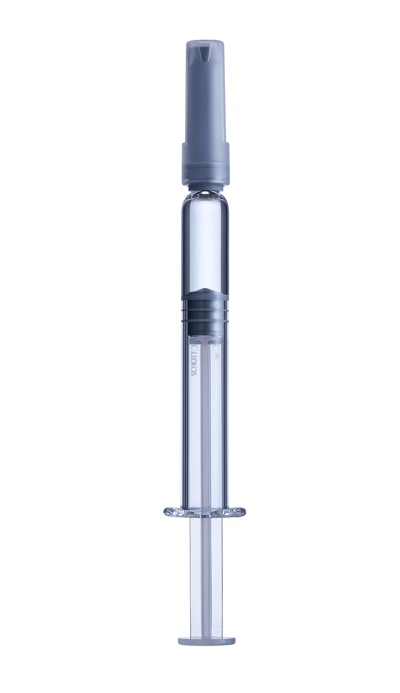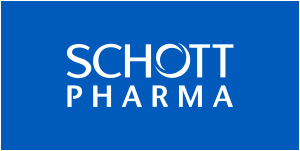Designed for use within the biologics market, SCHOTT has reviewed and updated many aspects of its glass syringe portfolio with the introduction of the syriQ BioPure syringe … although that may not be obvious to the naked eye. These prefillable glass syringes are intended to keep sensitive drugs stable throughout their shelf-lives, shorten time-to-market and make administration more convenient for patients.
“Sensitive and complex drugs are often highly viscous, which makes them more difficult to administer. Furthermore, they are prone to interaction with the container because of their complex molecular structure,” said Global Product Manager, Dr Nicolas Eon. “Biologics such as the protein-based monoclonal antibodies used in immunotherapy are very large molecules,” he notes, “comprising some 50,000 atoms assembled together. Heparin, by contrast, contains only 50 atoms.”
Currently, more than two thirds of drugs under development are biologics and SCHOTT, as a market leader in primary packaging, wants to be part of this journey. So, the company examined whether its standard syringe offering could meet the needs of this growing trend. Because of the structure-function relationship associated with complex biological moieties, maintaining their shape is fundamental to their efficacy. Yet, at the same time, they are extremely sensitive to environmental stressors such as temperature, agitation, etc., which can affect the conformation of the molecule and reduce its efficiency.
However, it’s only when the drug is introduced into a primary container that any real insight about the level of stability and interaction can be obtained. If it works, fine; but, if not, it may be necessary to reformulate the drug or examine other packaging options. “So,” says Nicolas, “our mission was to reduce the risk of drug–environment interaction and improve the stability of the active.” To improve the extractable profile of the syringe, syriQ BioPure syringes are manufactured under improved processes to lower the levels of tungsten and adhesive residuals and to ensure a uniform silicone layer — all validated and documented according to the latest US Food and Drug Administration (FDA) guidelines.
High-end materials
To enhance the extractable and leachable (E&L) profile, the syringes are made of highly inert FIOLAX borosilicate glass, which Dr Eon describes as the gold standard for packaging complex drug products. “Thanks to its strong track record, the suitability of this glass type for sensitive drugs is well researched,” he adds. “You won’t be able to tell the difference between the new syringes and our standard ones, but our customers will certainly notice the benefits. Furthermore, we’ve made considerable efforts to decrease the formation of tungsten oxide during production when attaching the forming pin to the syringe. Tungsten oxide is insoluble, extremely difficult to wash off and may, in some instances, directly influence the efficiency of the protein. So, we’ve addressed the root cause and, instead of creating the by-product in the first place, we’ve developed an ultra-low tungsten process by using an alternative pin material that does not produce any residual contaminants.”
“In addition, the syriQ BioPure syringes are available with a range of coated plungers/stoppers that are tailored for sensitive applications. In fact, more than 48 combinations with top-class elastomer components have been validated. Options include various closure systems, such as Aptar 4800, Aptar 4900, West 7025 and West 7028. The use of high-end materials further contributes to the superior E&L profile of syriQ BioPure,” says Dr Eon.
Another invisible improvement is the use of an improved UV-cured adhesive to attach the needle to the glass. “We don’t want this glue to interact with the drug product, so we redesigned the syringe tip to minimise the amount of glue required while retaining the same performance. We also optimised the gluing (polymerisation) process to ensure that we used 100% of the glue and that there is no residual monomer that might leach from the syringe,” he comments.
Yet another consideration, explains Nicolas, is the concept of particle interaction. “We need to be able to both identify and reduce the number of particles present in the syringe. To address this, we developed a completely new automated inspection system. We know that below the 250 µm level, manual detectability drops to approximately 50% … which for SCHOTT was not good enough. Focusing, therefore, on online inspection, we had to overcome the issue of the complex 3D geometry of the syringe (flange, tip, barrel, etc.) and the significant amount of light reflection. The existing system was only able to inspect the cylindrical section of the syringe, but we wanted a 100% view.”
He continues: “Our in-house solution is based on a combination of multiple cameras, multiple points of illumination and the generation of more than 1GB of data per syringe, which provides a detection limit down to 100 µm of 99%.”
Seamless autoinjector integration
The new glass syringes work with leading safety and autoinjector devices, meeting market demand for products that can be administered at home for patient comfort. Seamless integration into these devices is reached thanks to the syringe’s high dimensional accuracy. This includes glass tubing inspected with SCHOTT’s big data perfeXion process, additional dimensions beyond ISO requirement and new geometrical tolerances achieved by their cutting-edge forming technology and online inspection systems. This ensures device compatibility by design, superior functionality and a much better patient experience.
“Once you move from hospital care to home care,” notes Dr Eon, “syringe use can be quite scary or stressful for some people. So, to increase patient comfort and compliance, especially given the increasing use of biologics and the commensurate rise in applicators, it’s specifically designed to be used with self-administration devices.” He explains: “When you do a manual injection and you feel resistance, you push harder. That’s something an auto-injector can’t do; it will continue to apply the same pressure. As such, the process will slow down and the injection will take longer … which negatively impacts the patient experience. We wanted to make sure that the syringe sliding performance remains as constant as possible, from injection to injection and from syringe to syringe. Otherwise, in the worst case, if the force experienced by the syringe is too much, the auto-injector will stop and the patient won’t receive the full dose.”
To ensure dose consistency, SCHOTT completely redesigned its siliconisation procedure. “Today, we still need to put some silicone oil into the syringe to ensure that the rubber plunger/stopper can travel smoothly through the barrel. You need to ensure that the silicone layer is extremely consistent and homogenous to optimise the gliding properties and to ensure that the injection process can be completed, ideally, in the same amount of time, every time. Again, this was to improve the patient experience and, once again, it’s something that’s essentially invisible.”

Another aspect of moving from hospital (IV) to home (subcutaneous) delivery is the need to reduce the overall volume of the dose. “To do so and retain the same efficacy, you need to increase the concentration; with a 40–60 thousand atom compound, reducing the volume will, of course, increase its viscosity, which requires more pressure to deliver.”
“The auto-injector will no doubt need to be more powerful and the syringe itself will be exposed to more pressure and a higher likelihood of breakage,” observes Nicolas.
“Glass is an extremely resistant material … but the problem is that the introduction of micro-flaws reduces its strength and resilience. These micro-flaws are generally the result of glass-on-glass contact, which, ironically, are often invisible. To remedy this, we are now using a fully indexed manufacturing process so that the syringes are handled individually and contact is completely avoided. We also know that mechanical strength is adversely affected by cosmetic defects. Thanks to our newly developed inspection system, we have elevated our cosmetic defect specification levels to maintain the mechanical strength of our syringes.”
In summary
By focusing on a process of risk reduction, the latest member of SCHOTT’s iQ platform of ready-to-use packaging is delivered, presterilised, in a standard nest and tub. The syringes can be filled on a wide variety of standard RTU (ready-to-use) filling lines and are easy to handle. In addition, the syringes are 21 CFR Part 820-compatible and meet the design guidelines required to support combination products.
As all the required documentation is fully available, the pharmaceutical industry benefits from shorter times to market. And, featuring ultra-low tungsten levels, low adhesive residuals and accurate dimensions for optimal device compatibility, these prefillable syringes have been designed to ensure drug stability and ease administration.
“We have to keep up with the needs of drug manufacturers,” concludes Dr Eon, “including the rapid rise in biologics and protein-based actives; but, what really drives us to improve our products and break new ground is that behind every development in syringe technology is a patient that needs a treatment.”





